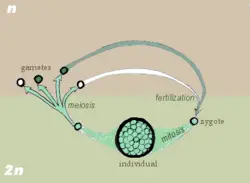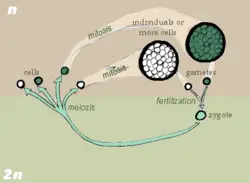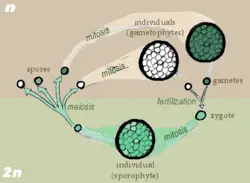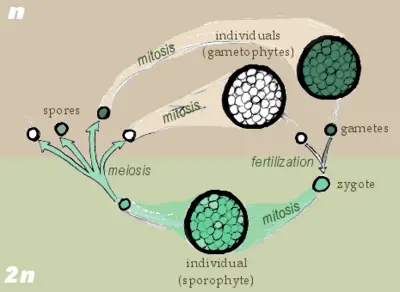Life cycle
In biology, life cycle is the series of changes that an organism undergoes from its inception by means of reproduction, whether through asexual reproduction or sexual reproduction, to the inception of the following generation in that same phase of the cycle.
For some organisms, particularly small, simple organisms such as bacteria and some protists, the life cycle is complete in one generation. This is also the case for many animals, where the male and female gamete fuse to form the new offspring. In plants, reproduction is multi-generational, also known as alternation of generations.
While life cycle types can be placed into a few broad categories (haplontic, diplontic, etc.), the specific life cycles of individual species show great diversity, such as the timing of the onset of various stages, methods of fertilization, and so forth. Diversity among living organisms is a basic biological principle and an important component in the joy humans experience from nature. Of course, organisms in closely-related species and taxa share similar life cycles. The near ubiquitous presence of sexual reproduction, combined with genetic recombination, promotes uniqueness among individuals as well.
Sexual reproduction life cycles
Three types of life cycles exist, depending on ploidy, a multiple of the number of chromosomes in a cell:
- haplontic life cycle
- diplontic life cycle
- diplobiontic life cycle (also referred to as diplohaplontic, haplodiplontic, or dibiontic life cycle)
These three types of cycles feature alternating haploid (n) and diploid (2n) phases.
The haploid organism becomes diploid through fertilization, with joining of gametes. This results in a diploid zygote. To return to a haploid stage, meiosis must occur.
The cycles differ in the product of meiosis, and whether mitosis (growth) occurs. Zygotic and gametic meiosis have one mitotic stage and form during the n phase in zygotic meiosis and during the 2n phase in gametic meiosis. Therefore, zygotic and gametic meiosis are collectively term haplobiontic (single meiosis per phase). Sporic meiosis, on the other hand, has two meiosis events (diplobiontic): one in each phase.
Diplontic life cycle
In gametic meiosis, the diploid zygote undergoes mitosis to produce a multicellular diploid individual or a group of more diploid cells. Cells from the diploid individuals then undergo meiosis to produce haploid gametes.
The haploid gametes do not undergo mitosis, and do not grow into a larger haploid organism. Rather, the haploid gametes fuse and produce the diploid zygote with gametes of the opposite type.
In the whole cycle, gametes are the only haploid cells; mitosis occurs only in the diploid phase.
The diploid multicellular individual is a diplont, hence a gametic meiosis is also called a diplontic life cycle. Diplonts include:
- Animals
- Some brown algae
Haplontic life cycle
A zygotic meiosis is a meiosis of a diploid zygote immediately after karyogamy, the fusion of two cell nuclei. In this way, the organism ends its diploid phase and produces several haploid cells. These cells undergo mitosis (divide mitotically) to form either larger, multicellular individuals, or more haploid cells. Two opposite types of gametes (e.g., male and female) from these individuals or cells fuse to become a diploid zygote.
In the whole cycle, zygotes are the only diploid cell; mitosis occurs only in the haploid phase.
The individuals or cells as a result of mitosis are haplonts, hence this life cycle is also called haplontic life cycle. Haplonts are:
- All fungi
- Some green algae
- Many protozoa
Diplobiontic life cycle
In sporic meiosis, also known as intermediary meiosis, mitoses occur in both the diploid and haploid phases. The organism exhibits alternation of generations, which features spore-producing multicellular sporophytes (which are diploid) and gamete-producing multicellular gametophytes (which are haploid). Diagramatically, sporic meiosis looks like the complex halves of gametic meiosis and zygotic meiosis are merged into one.
This type of cycle is diplobiontic (also known as diplohaplontic, haplodiplontic, or dibiontic).
Sporic meiosis occurs in plants and many algae. Having multicellular individuals in both phases means that for some seaweeds, it is difficult to determine if a macroscopic specimen is gametophytic or sporophytic unless observed under a microscope, this is called isogamy. However, not all species with sporic meiosis have both large gametophyte and sporophyte generations. The trend in higher plants is having smaller gametophytes that are more dependent and parasitic on sporophytes, a phenomena known as heterogamy.
Asexual reproduction life cycle
In cases of asexual reproduction, the life cycle is complete in one generation, where an individual inherits all of its chromosomes from one parent and is genetically identical to its parents. Prokaryotes, such as bacteria, undergo binary fission, where each cell divides in half to form two cells with identical DNA to the original cell. In order for the original cell to divide, the prokaryotic chromosome that is a single DNA molecule must first replicate and then attach itself to a different part of the cell membrane. Most protists, unicellular eukaryotes, also reproduce asexually, except under stress they reproduce sexually.
Binary fission
Binary fission is the form of asexual reproduction used by most prokaryotes to reproduce. This process results in the reproduction of a living cell by division into two equal or near-equal parts.
Binary fission begins when the DNA replication occurs. Each circular DNA strand then attaches to the cell membrane. The cell elongates, causing the two chromosomes to separate. The cell membrane then invaginates (grows inwards) and splits the cell into two daughter cells through a process called cytokinesis.
Organisms that reproduce through binary fission generally grow exponentially.
This type of asexual reproduction normally results in two identical cells. However, bacterial DNA has a relatively high mutation rate. This rapid rate of genetic change is what makes bacteria capable of developing resistance to antibiotics and helps them exploit invasion into a wide range of environments.
Various single-celled eukaryotes also reproduce by the splitting of the original cell into two cells, although this involves mitosis and cytokinesis similar to the cells of a multicellular eukaryote organisms. While historically these eukaryote single-cell divisions have been referred to in the literature as binary fission, this term today is often reserved for prokaryote reproduction, which does not involve mitosis since they lack a membrane-bounded nucleus. Among eukaryotes that reproduce by the splitting of the original cell into two are
- Most protists (for example, Amoeba proteus)
- Entamoeba histolytica (a protozoan that is a human intestinal parasite)
- Pyrodictium abyssi (an anaerobic hyperthermophilic archaea of deep-sea hydrothermal vents)
- Schizosaccharomyces pombe (a fungal organism that is a species of yeast)
In addition, the mitochondria and chloroplasts of eukaryote cells also divide by binary fission.
Many multicellular organisms also have the ability to reproduce asexually. Many such organisms will bud off a localized cluster of cells, which then grows through mitosis to form a new individual. Animals such as sponges can reproduce by fragmenting their bodies. Many plants have the ability to reproduce asexually as well.
Alternation of generations
Alternation of generations is a term applied to a reproductive cycle (a diplobiontic life cycle) of certain vascular plants, fungi, and protists. The term is a bit confusing for people familiar only with the life cycle of a typical animal. A more understandable name would be "alternation of phases of a single generation" because we usually consider a generation of a species to encompass one complete life cycle. The life cycle of organisms with "alternation of generations" is characterized by each phase consisting of one of two separate, free-living organisms: a gametophyte (thallus or plant), which is genetically haploid, and a sporophyte (thallus or plant), which is genetically diploid.
A haploid plant of the gametophyte generation produces gametes by mitosis. Two gametes (originating from different organisms of the same species or from the same organism) combine to produce a zygote, which develops into a diploid plant of the sporophyte generation. This sporophyte produces spores by meiosis, which germinate and develop into a gametophyte of the next generation. This cycle, from gametophyte to gametophyte, is the way in which plants and many algae undergo sexual reproduction.
Distinctions
The distinction of "free-living" is important, because all sexually reproducing organisms can be thought to involve alternating phases, at least at the cellular level as meiosis. However, not all biologists agree. It is often stated that alternation of generations refers to both the diploid and haploid stages being "multicellular" and this is more important than "free-living" (Taylor T.N. et al. 2005). Such a distinction changes the concept to one separating animals and plants.
All plants have diploid sporophyte and haploid gametophyte stages that are multicellular, and the differences between plant groups are in the relative sizes, forms, and trophic abilities of the gametophyte or sporophyte forms, as well as the level of differentiation in the gametophytes. An example would be comparing pollen and ovules to bisexual gametophyte thalli.
Biologists recognize two categories of alternation: the first if the sporophyte and the gametophyte forms are more or less identical, alternation is called isomorphic; and second if the forms have very different appearances, alternation is called heteromorphic. As noted above, terms applied to this kind of life cycle are variously called diplobiontic, diplohaplontic, haplodiplontic, or dibiontic.
Heterogamy is a term used to describe alternation between parthenogenic and sexually reproductive phases that occurs in some invertebrates and vertebrates. Although conceptually similar to "alternation of generations," the genetics of heterogamy is significantly different.
Fungi
Fungal mycelia are typically haploid. When mycelia of different mating types meet, they produce two multinucleate ball-shaped cells, which join via a "mating bridge." Nuclei move from one mycelium into the other, forming a heterokaryon (meaning "different nuclei"). This process is called plasmogamy. Actual fusion to form diploid nuclei is called karyogamy, and may not occur until sporangia are formed. Karogamy produces a diploid zygote, which is a short-lived sporophyte that soon undergoes meiosis to form haploid spores. When the spores germinate, they develop into new mycelia.
Protists
Some protists undergo an alternation of generations, including the slime molds, foraminifera, and many marine algae.
The life cycle of slime molds is very similar to that of fungi. Haploid spores germinate to form swarm cells or myxamoebae. These fuse in a process referred to as plasmogamy and karyogamy to form a diploid zygote. The zygote develops into a plasmodium, and the mature plasmodium produces, depending on the species, one to many fruiting bodies containing haploid spores.
Foraminifera undergo a heteromorphic alternation of generations between a haploid gamont and a diploid agamont phases. The single-celled haploid organism is typically much larger than the diploid organism.
Alternation of generations occurs in almost all marine seaweeds. In most red algae, many green algae, and a few brown algae, the phases are isomorphic and free-living. Some species of red algae have a complex triphasic alternation of generations. Kelp are an example of a brown alga with a heteromorphic alternation of generations. Species from the genus Laminaria have a large sporophytic thallus that produces haploid spores which germinate to produce free-living microscopic male and female gametophytes.
Plants
Non-vascular plants
Nontracheophyte plants including the liverworts, hornworts and mosses undergo an alternation of generations; the gametophyte generation is the most common. The haploid gametophyte produces haploid gametes in multicellular gametangia. Female gametangia are called archegonium and produce eggs, while male structures called antheridium produce sperm. Water is required so that the sperm can swim to the archegonium, where the eggs are fertilized to form the diploid zygote. The zygote develops into a sporophyte that is dependent on the parent gametophyte. Mature sporophytes produce haploid spores by meiosis in sporangia. When a spore germinates, it grows into another gametophyte.
Vascular plants
Ferns and their allies, including clubmoss and horsetails, reproduce via an alteration of generations. The conspicuous plant observed in the field is the diploid sporophyte. This plant creates by meiosis single-celled haploid spores, which are shed and dispersed by the wind (or in some cases, by floating on water). If conditions are right, a spore will germinate and grow into a rather inconspicuous plant body called a prothallus.
The haploid prothallus does not resemble the sporophyte, and as such ferns and their allies have a heteromorphic alternation of generations. The prothallus is short-lived, but carries out sexual reproduction, producing the diploid zygote that then grows out of the prothallus as the sporophyte.
Mammal reproduction and early life cycle
In placental mammals, offspring are born as juveniles: complete animals with the sex organs present although non-functional. After several months or years, the sex organs develop further to maturity and the animal becomes sexually mature. Most female mammals are only fertile during certain periods and during those times, they are said to be "in heat." At this point, the animal is ready to mate. Individual male and female mammals meet and carry out copulation.
Gestation, called pregnancy in humans, is the period of time during which the fetus develops, dividing via mitosis inside the female. During this time, the fetus receives all of its nutrition and oxygenated blood from the female, filtered through the placenta, which is attached to the fetus' abdomen via an umbilical cord. Once the fetus is sufficiently developed, chemical signals start the process of birth. The newborn, which is called an infant in humans, should typically begin respiration on its own shortly after birth.
In monotremes, the females lay eggs. They hold the eggs internally for several weeks, providing nutrients, and then lay them and cover them like birds. After less than two weeks the young hatches and crawls into its mother’s pouch, much like marsupials, where it nurses for several weeks as it grows.
Marsupials reproduce in essentially the same manner, though their young are born at a far earlier stage of development than other mammals. After birth, marsupial joeys crawl into their mother’s pouch and attach to a teat, where they receive nourishment and finish developing into self-sufficient animals.
Life history theory
In animal and human biology, life history theory is a method of understanding evolved behaviors and strategies to optimize reproductive success.
Life history theory is an analytical framework widely used in biology, psychology, and evolutionary anthropology, which postulates that many of the physiological traits and behaviors of individuals may be best understood in terms of the key maturational and reproductive characteristics that define the life course.
Examples of these characteristics include:
- Age at weaning
- Age of sexual maturity or puberty
- Adult body size
- Age specific mortality schedules
- Age specific fecundity
- Time to first sexual activity or mating
- Time to first reproduction
- Duration of gestation
- Litter size
- Interbirth interval
Variations in these characteristics reflect differing allocations of an individual's resources (i.e., time, effort, and energy expenditure) to competing life functions, especially growth, body maintenance, and reproduction. For any given individual, available resources in any particular environment are finite. Time, effort, and energy used for one purpose diminishes the time effort, and energy available for another. For example, resources spent growing to a larger body size cannot be spent increasing the number of offspring. In general terms, the costs of reproduction may be paid in terms of energy being diverted away from body repair and maintenance and by reducing investment in immunological competence.
ReferencesISBN links support NWE through referral fees
- Dettmering, C., et al. 1998. The trimorphic life cycle in foraminifera: Observations from cultures allow new evaluation. European Journal of Protistology 34:363-368.
- Graham, L., J. Graham, and L. Wilcox. 2003. Plant Biology. Upper Saddle River, NJ: Pearson Education.
- Raven, P. H., and G. B. Johnson. 1996. Biology. Dubuque, IA: Wn.C. Brown Publishers.
- Roff, D. 1992. The Evolution of Life Histories: Theory and Analysis. New York: Chapman & Hall.
- Stearns, S. 1992. The Evolution of Life Histories. Oxford, England: Oxford University Press.
- Taylor, T. N., et. al. 2005. Life history biology of early land plants: Understanding the gametophyte phase. Proceedings of the National Academy of Sciences 102:5892-5897.
Credits
New World Encyclopedia writers and editors rewrote and completed the Wikipedia article in accordance with New World Encyclopedia standards. This article abides by terms of the Creative Commons CC-by-sa 3.0 License (CC-by-sa), which may be used and disseminated with proper attribution. Credit is due under the terms of this license that can reference both the New World Encyclopedia contributors and the selfless volunteer contributors of the Wikimedia Foundation. To cite this article click here for a list of acceptable citing formats.The history of earlier contributions by wikipedians is accessible to researchers here:
- Life_cycle  history
- Sexual_reproduction  history
- Alternation_of_generations  history
- Life_history_theory  history
- Binary_fission  history
The history of this article since it was imported to New World Encyclopedia:
Note: Some restrictions may apply to use of individual images which are separately licensed.






